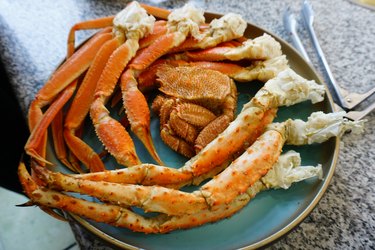
Snow crabs, also known as "queen" crabs — because they're somewhat smaller than king crabs — abound in colder parts of the Atlantic and Pacific. Many people find the crabs' legs delicious enough to eat by the pound, making the actual calories in crab legs' massive servings an obvious question.
Tip
Wondering about snow crab legs nutrition facts? Although 1 pound of snow crab legs represents considerably more than the recommended serving, the caloric “hit” from them is about 520 calories.
Video of the Day
“Crabbing” by the Numbers
In general, 3 ounces is the recommended serving for most protein selections, including crab legs. According to the U.S. Department of Agriculture (USDA), there are about 100 calories in crab legs, for a 3-ounce serving (85 grams). Restaurants often serve patrons a full "cluster" of snow crab legs, which are at least 6 ounces (170 grams), or about 200 calories.
Video of the Day
To calculate for a full pound, it helps to know that 100 grams of snow crab legs contain about 115 calories, as per the USDA. There are just over 450 grams in 1 pound. This means that if you were to eat a full pound of snow crab legs, the calorie estimate is approximately 520 in total.
Ideally, 10 to 35 percent of your daily calories should come from protein, according to the Mayo Clinic. For someone on a 2,000-calorie-a-day diet, a pound of crab legs would be more than 25 percent of the protein calories you should have for the entire day. Given that standard, a sensible plan would involve having smaller amounts of protein for your other meals, so that you don't exceed the maximum daily intake of protein that's normally recommended.
Read more: Are Crab Legs a Healthy Food?
Counting Crab Calories and Fat
There are other reasons not to blow your protein and calorie "budget" on 1 pound of snow crab legs (except on special occasions, of course). While crab calories and fat aren't high in a standard serving of snow crab legs, the crab legs do contain relatively high amounts of sodium and dietary cholesterol.
For a regular, 3-ounce serving of snow crab legs, the cholesterol content is about 20 percent of the amount you should have in one day, according to USDA charts. Similarly, the amount of sodium in the normal serving is about 25 percent of your daily value of sodium.
By taking in one pound, however, you'd be surpassing your recommended daily doses for both dietary cholesterol and sodium. If you do choose to eat more than a normal serving of snow crab legs, it's important to keep the rest of your intake as free from rich, salty foods as possible.
Snow Crab Legs Nutrition Facts
Whether served jumbo-sized or as a normal serving, snow crab legs are high in several key nutrients. The USDA notes that a 3-ounce portion contains more than 368 percent of the recommended daily dose of vitamin B12. It also provides at least 10 percent of the recommended daily doses of iron, magnesium and zinc.
In addition, snow crab legs provide calcium, potassium, vitamin A and vitamin C. If you choose to double or quadruple your portion, you'll obviously be exceeding your daily dose requirements of all of these nutrients.
Read more: 4 Types of Food a Pescatarian Can Eat
However many calories in crab legs you decide to indulge in when it comes to your portion, it helps to know how to keep the rest of the meal as healthy as possible. The most important option is controlling what you drizzle over the legs, or dip them into.
The juice from a couple of lemon wedges has less than 10 calories, according to the USDA. Melted butter is much less heart-healthy. Each tablespoon of butter used is about 100 calories.
In fact, snow crab calories and fat can be hard to keep out of a classic snow crab dinner — especially when dining out. The American Heart Association suggests passing up the buttery biscuits in favor of a complex carb option like wild rice, a whole grain roll or even plain popcorn. Instead of mayo-heavy coleslaw, opt for healthier sides such as a garden salad or a zucchini "noodle" salad.